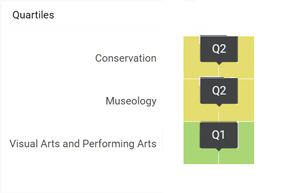A new aesthetic proposal for “Men at arms” by Donato Bramante
Abstract
During the refurbishing of the “Lombard Art of the XV-XVI century” department at the Pinacoteca di Brera (Milan), concluded in 2018, the Conservation and Restoration Center “La Venaria Reale” had the opportunity to study and restore the famous pictorial cycle of Men at Arms by Donato Bramante (1488-89).
The paper aims to present the methodological approach and the results obtained with the last conservation treatment, aimed at a new and updated aesthetic proposal for the pictorial cycle. The main objective was to re-establish the unity of the images, compromised by the numerous lacunae left visible by previous treatments, respecting at the same time the material features of the paintings and the evidence of their particular conservative history.
The interdisciplinary work group* has reconstructed the complex conservative history of the detached wall paintings, thanks to the technical observation of the surfaces and the scientific characterization of the constituent materials. The results were compared with the available historical documentation, in particular with historical photographs. The project allowed us to retrace the profound changes that the concept of pictorial integration has encountered over time, from the beginning of the twentieth century to the present day. The conservation treatment also originated from the need of the Pinacoteca di Brera to update the aesthetic presentation of the works, facilitating the reading of the fragmented images due to numerous lacunae. d images due to numerous lacunae.
Downloads
References
AUTELLI F. (1989). Pitture murali a Brera. Bergamo: Istituto per la storia dell’arte lombarda.
BASILE G. (2010). “La restituzione del testo pittorico nel ciclo di Giotto alla cappella Scrovegni e nei dipinti murali della Basilica Superiore di San Francesco in Assisi”. In: I colori di Giotto. La Basilica di Assisi: restauro e restituzione virtuale. http://www.giuseppebasile.org/restauri/la-basilica-di-s-francesco-ad-assisi/37-la-restituzione-del-testo-pittorico-nel-ciclo-di-giotto-alla-cappella-scrovegni-e-nei-dipinti-murali-della-basilica-superiore-di-san-francesco-in-assisi, [accessed 13/04/2020].
BASILE G. (2014). “I ritocchi e le integrazioni”. In: PHILIPPOT P. Istituto Centrale del Restauro, la sua organizzazione e le sue posizioni riguardo ai principali problemi del restauro dei dipinti . Palermo: Provenzani Editore. 176-185.
CASAZZA O. (2007). Il restauro pittorico nell’unità di metodologia. Florence: Nardini.
CORNALE P., MARITAN L., MAZZOLI C. et al. (2005). “Affresco e mezzo fresco: studio sperimentale e procedure analitiche per la caratterizzazione delle tecniche pittoriche”. In: Sulle pitture murali: Riflessioni. Conoscenze. Interventi, Proceedings of the Conference Scienza e beni culturali XXI. Marghera: Arcadia Ricerche. 687-696.
CREMONESI P. (2019). L’ambiente acquoso per il trattamento di manufatti artistici. Padova: Il Prato.
DI MARCELLO S., NOTARSTEFANO C. (2011). “La verifica della durabilità dei colori ad acquerello impiegati nella reintegrazione dei dipinti murali”. In A scuola di restauro: le tesi migliori degli allievi dell’Istituto Superiore per la Conservazione ed il Restauro e dell’Opificio delle Pietre Dure negli anni 2005-2007. Rome: Gangemi. 71-81.
GIANNINI C. (2006). Giovanni Secco Suardo alle origini del restauro moderno. Florence: Edifir.
GIANNINI C. (2013). “Attilio Steffanoni (1881-1947). Biografia di un collezionista restauratore”. In: La cultura del restauro. Modelli di ricezione per la museologia e la storia dell’arte. Proceedings of the Conference. Rome: Campisano Editore. 595-606.
GIOVANNONE C., OZINO E., SCARPITTI P. et. al. (2015). “Uno stucco particolare per i dipinti murali staccati di Giusto dei Menabuoi del battistero di della cattedrale di Padova”. In: Proceedings of the Conference Lo Stato dell’Arte XIII. Florence. 89-101.
GRAZIOSI F. (2011). “Le alterazioni dei materiali per la reintegrazione pittorica dei dipinti murali”. In A scuola di restauro: le tesi migliori degli allievi dell’Istituto Superiore per la Conservazione ed il Restauro e dell’Opificio delle Pietre Dure negli anni 2005-2007. Rome: Gangemi. 93-100.
MARIOTTI P.I. (2014). “L’Annunciazione di Sandro Botticelli proveniente dallo Spedale di San Martino alla Scala: dal distacco di Lucarini alle problematiche attuali”, OPD Restauro, 26: 151-164.
MULAZZANI G., DALAI EMILIANI M., MATALON S., et. al. (1977). Donato Bramante: gli Uomini d’arme. Florence: Centro Di.
NADOLNY J. (2012). “History of visual compensation for paintings”. In: The Conservation of Easel Paintings. New York: Routledge. 573-585.
PELOSI C., MARABELLI M., FALCUCCI C. et. al. (2009). “Problematiche conservative degli acquerelli nel restauro”. Archeomatica, 0: 24-27.
RINALDI S. (2011). Storia tecnica dell’arte. Materiali e metodi della pittura e della scultura (secc. V-XIX). Rome: Carocci.
ROSSI F. (2014). “A margine di Luca Beltrami disegnatore e dei suoi doni”. In: Luca Beltrami (1854-1933). Storia, arte e architettura a Milano. Milan: Silvana Editoriale. 239-249.
SÁNCHEZ ORTIZ A., SÁNCHEZ LEDESMA A., SEDANO ESPÍN U. et. al. (2009). “Investigación sobre la estabilidad química y óptica de materiales contemporáneos para reintegración cromática”. En IV Congreso del GEIIC (Cáceres, 25-27 noviembre 2009), 195-205.
VV. AA (1988). Bramante a Milano. Proceedings of the Conference. Special issue of Arte Lombarda. 86-87. Milan: Il Vaglio Cultura Arte.
VV. AA. (2009). Lacuna: riflessioni sulle esperienze dell’Opificio delle Pietre Dure. Proceedings of the Conference: Salone dell’arte del Restauro e della Conservazione dei Beni Culturali e Ambientali di Ferrara (7th April 2002 and 5th April 2003), Florence: Edifir.
VV. AA. (2015). Donato Bramante a Milano. Le arti in Lombardia 1477-1499. Milan: Skira.
- Copyright and intellectual property belongs to author. Author guarantees editing and publishing rights to Ge-Conservación Journal, under a Creative Commons Attribution License. This license allows others to share the work with authorship and the original source of publication acknowledgement.
- Articles can be used for scientific and educational purposes but never for commercial use, being sanctioned by law.
- The whole content of the article is author’s responsibility.
- Ge-Conservación Journal and authors may establish additional agreements for non-exclusive distribution of the work version published at the Journal (for example, on institutional repositories or on a book) with acknowledgment of the original publication on this Journal.
- Author is allowed and encouraged to disseminate his works electronically (for example, on institutional repositories or on its own website) after being published on Ge-Conservación Journal. This will contribute for fruitful interchanges as also for wider and earlier citations of the author’s works.
- Author’s personal data will only be used for the Journal purposes and will not be given to others.









